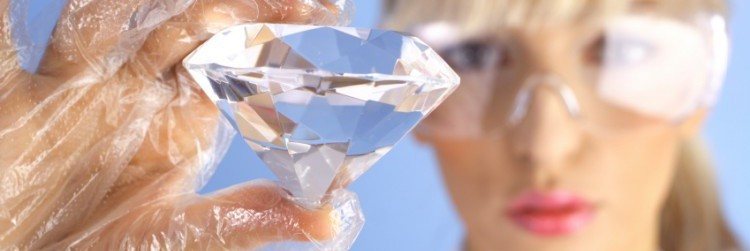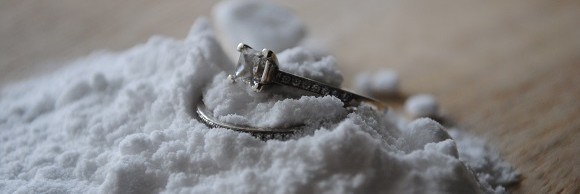At Brilliance, jewelry shoppers can expect the highest quality loose diamonds and diamond jewelry. Many jewelry retailers opt to sell synthetic diamonds, instead of natural diamonds, because they are less expensive. If you are purchasing a diamond on a budget, you should know the differences between a synthetic diamond and a natural diamond prior to making your purchase.
What is a “Synthetic” Diamond?
Technically, a synthetic diamond is one that is created by artificial, rather than geological, means. The term “synthetic” encompasses many other terms related to diamonds including “man-made,” “lab-created,” “laboratory-grown,” “cultured diamond,” and “cultivated diamond.” These diamonds, like natural diamonds, are made from carbon and have the same refractive index, density, hardness, dispersion, and crystalline structure as those diamonds mined from the Earth. Synthetic diamonds are often confused with another non-natural diamond called a “diamond simulant,” which we will discuss later in more detail. One of the most common methods of creating synthetic diamonds is Chemical Vapor Deposition (CVD).
Chemical Vapor Deposition
First produced about ten years ago, CVD diamonds are relatively new to the jewelry market. As the name suggests, carbon-based gases are heated to extremely high temperatures inside the CVD machine until the molecules break apart, releasing the carbon atoms. These atoms rain down onto a diamond substrate at the bottom of the machine, building up on one another like snowflakes to form the layers of the diamond. Many of the early CVD diamonds were black or brown, but scientists found that by changing the gases in the machine and treating the gases at high temperatures and high pressure, colorless diamonds could be created. Today, it can be very difficult to tell the difference between a natural diamond and a CVD diamond.
Diamond Simulants
These stones may look like a diamond to the naked eye, but technically, they are very different. Far less expensive than both natural and synthetic diamonds, diamond simulants include such materials as Cubic Zirconia (CZ), high-leaded glass (rhinestones), white sapphire, moissanite, and Yttrium aluminum garnet (YAG). None of the simulants are created solely from carbon, and only CZ and YAG have the same crystalline structure as a natural or synthetic diamond. The density, refractive index, and dispersion are all different compared to those of a diamond, and all the simulants earned a softer rating than the diamond’s “10” rating on the Mohs Scale.
Cubic Zirconia
One of the most popular diamond simulants is Cubic Zirconia. Available on the jewelry market since 1976, CZ is created from zirconium dioxide, making it heavier than a natural diamond. The added weight makes it more difficult for light to pass through the stone easily, giving the CZ a lower refractive index (and therefore less brilliance) than the natural diamond. While the affordable price of the CZ is enticing, many diamond aficionados agree that they look “too perfect,” making them unrealistic substitutes for diamonds.
Moissanite
First discovered in 1893 by Henri Moissan, this diamond substitute is relatively new to the jewelry industry. Moissan initially thought the silicon carbide crystals he found in a meteor crater in Canyon Diablo, Arizona were diamonds; however, upon closer inspection he found this mineral to have a different chemical composition than a diamond. The mineral was named “Moissanite” later in Moissan’s life, after its discoverer.
Occurring naturally in meteorites, and as inclusions in diamonds, xenoliths, and ultramafic rocks, Moissanite is very rare in its natural form. Due to the scarcity of this mineral, today’s Moissanite is manufactured in laboratories for use in jewelry, making it one of the most available synthetic diamonds.
Moissanite loose gems rate between a 9.25 and 9.5 on the Mohs Scale, making it one of the hardest minerals on Earth and a good natural diamond substitute for industrial use as abrasives and cutting material. As a gemstone 120% stronger than CZ, Moissanite better resists abrasion and scratching. Its unique crystalline structure is different from a natural diamond because it does not exhibit a direction of cleavage–a trait, some argue, that makes it stronger than a diamond.
Introduced to the jewelry market in 1998, Moissanite’s optical qualities, lower price, and ethical production method quickly made it popular as a synthetic option to natural diamonds. In comparison, Moissanite’s color often falls in the I-J-K range of the diamond grading scale, and is comparable in clarity to a diamond with a VS rating. With a higher refractive index than a natural diamond, and 50% greater luster than CZ, Moissanite is a very shiny, convincing synthetic. Between its sparkle and its similar thermal conductivity to that of a natural diamond, Moissanite is often used by scammers to sell a synthetic diamond under the guise of the real thing. Unlike CZ, Moissanite and natural diamond have similar thermal conductivity, making it difficult to differentiate the two using traditional thermal conductivity testing. Instead, opt for an electrical conductivity test if you encounter an unscrupulous individual trying to sell you a Moissanite for the cost of a natural diamond.
Identifying Synthetic Diamonds
When you decide to purchase a diamond, it is important to know exactly what you are getting. Natural diamonds should come with a graded certificate from a nationally-recognized gemological institute. If your stone does not have a certificate, you should ask your jeweler to provide one to ensure the authenticity of the diamond. Most brightly-colored diamonds are synthetic, although color is not always the best determining factor. Used to view the structure or growth pattern of the diamond, a spectrometer is a good tool to use to identify synthetic diamonds, which grow in a pattern different from that of a natural diamond. Conductivity is a useful method to tell the difference between a natural diamond and a simulant. Diamonds conduct heat, while most simulants do not; likewise, the simulant moissanite will conduct electricity but a natural diamond will not.
Whether you choose a natural or synthetic diamond, a loose stone or a piece of diamond jewelry, when you purchase from Brilliance, have confidence that your gem will last for many generations.





